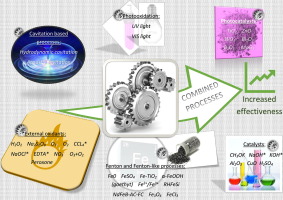Chemical Engineering Journal ( IF 13.3 ) Pub Date : 2018-01-09 , DOI: 10.1016/j.cej.2018.01.049 Michał Gągol , Andrzej Przyjazny , Grzegorz Boczkaj

|
Hydrodynamic and acoustic cavitation combined with advanced oxidation processes (AOPs), including, among others, the Fenton process, is a promising alternative to the technologies of wastewater treatment technologies in use today. The present review discusses processes based on cavitation combined with AOPs and evaluates their effectiveness in oxidation of organic contaminants. Complete degradation of, among others, p-nitrotoluene, p-aminophenol, 1,4-dioxane, alachlor, chloroform, trichloroethylene, sodium pentachlorophenate and carbon tetrachloride was achieved by using hydrodynamic cavitation or acoustic cavitation alone. Cavitation is also an effective method of disinfection of water. Complete oxidation of hardly degradable organic contaminants, including pharmaceuticals, organic dyes, insecticides, phenol and its derivatives was observed when using hybrid processes: hydrodynamic or acoustic cavitation combined with the Fenton process, ozonation, hydrogen peroxide, UV irradiation, catalysts and persulfates. The review also discusses the cavitational reactors used in the wastewater treatment and the effect of process parameters (including pH, temperature, concentration and kind of contaminants) on the effectiveness of oxidation. The oxidation effectiveness for individual treatment methods is compared and their advantages and limitations discussed. The analysis of economics of the treatment processes performed to evaluate the possibility of scaling up reveals that the only economical processes should be based on hydrodynamic cavitation (mainly due to low cost of reactors and low consumption of electrical energy compared with ultrasonic reactors).
中文翻译:

通过基于空化作用的高级氧化工艺处理废水–综述
流体动力和声空化与先进的氧化工艺(AOP)结合在一起,包括Fenton工艺,是当今使用的废水处理技术的有希望的替代方法。本综述讨论了基于空化结合AOP的过程,并评估了它们在氧化有机污染物方面的有效性。对硝基甲苯p的完全降解单独使用水力空化或声空化可制得-氨基苯酚,1,4-二恶烷,丙草胺,氯仿,三氯乙烯,五氯酚钠和四氯化碳。空化也是对水进行消毒的有效方法。当使用混合工艺时,观察到几乎不可降解的有机污染物,包括药物,有机染料,杀虫剂,苯酚及其衍生物的完全氧化:与Fenton工艺相结合的流体动力学或声空化,臭氧化,过氧化氢,紫外线辐射,催化剂和过硫酸盐。该评论还讨论了用于废水处理的空化反应器以及工艺参数(包括pH值,温度,浓度和污染物种类)对氧化效果的影响。比较了各种处理方法的氧化效果,并讨论了它们的优点和局限性。为评估扩大规模的可能性而进行的处理过程的经济学分析表明,唯一的经济过程应基于流体动力空化(主要是由于与超声反应堆相比,反应堆的成本较低且电能消耗较低)。











































 京公网安备 11010802027423号
京公网安备 11010802027423号